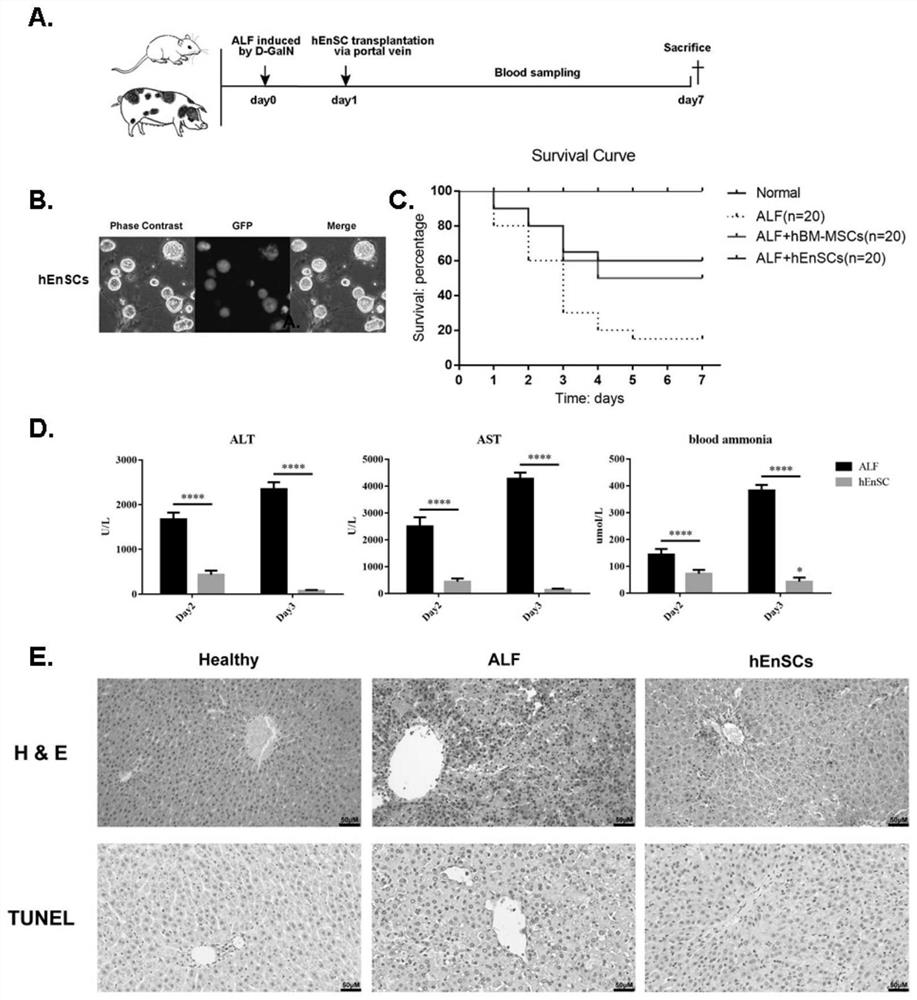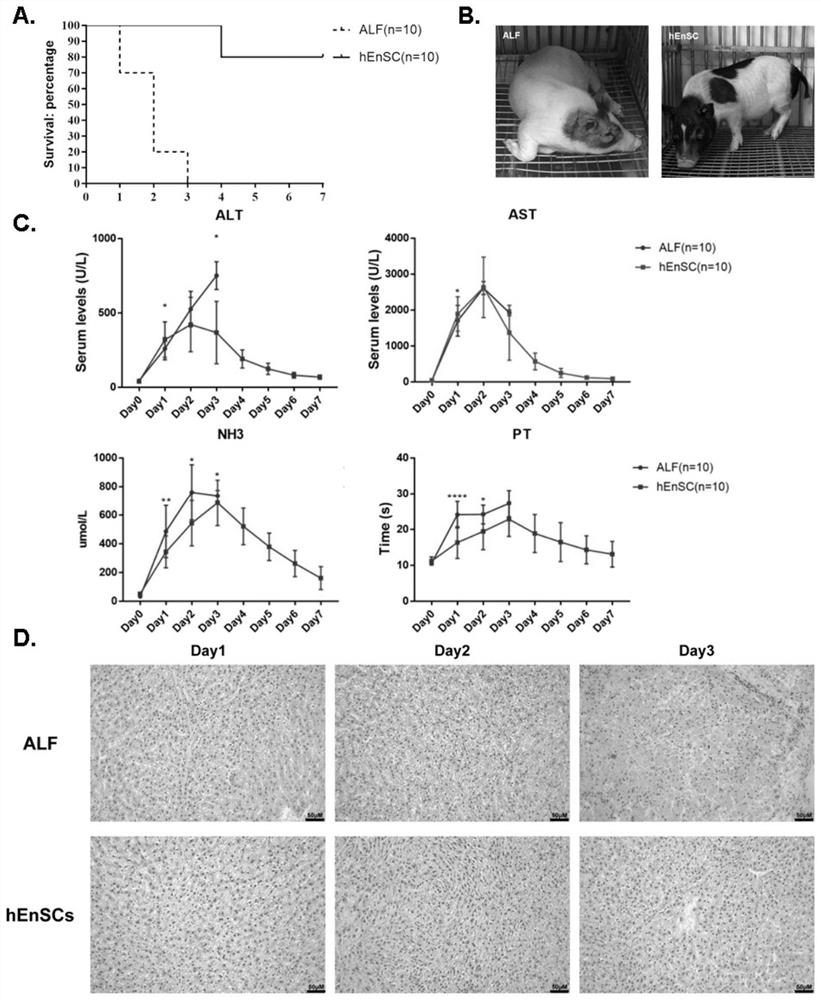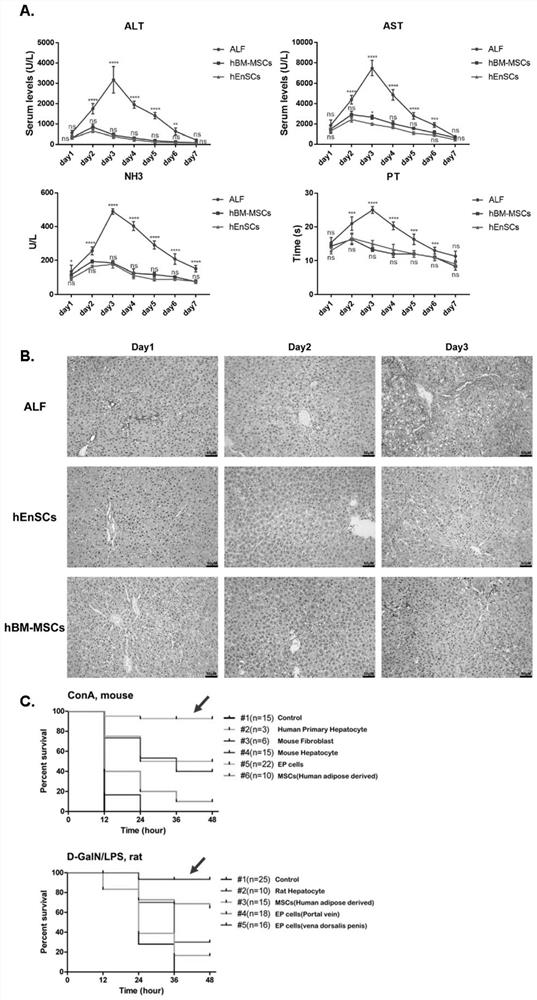Application of entoderm stem cell in prevention and/ or treatment of liver immune disorder disease
A technology of immune disorders and stem cells, applied in the field of biomedicine, can solve problems such as complex sources of MSCs
- Summary
- Abstract
- Description
- Claims
- Application Information
AI Technical Summary
Problems solved by technology
Method used
Image
Examples
Embodiment 1
[0114] Example 1 Efficacy evaluation of hEnSCs transplantation in the treatment of acute liver failure in a rat model
[0115] In order to comprehensively evaluate the efficacy of hEnSCs in the treatment of acute liver failure, different animal models, including mice and pigs, were used to measure the efficacy of hEnSCs in the treatment of acute liver failure ( figure 1 A). In a commonly used rat model, D-GalN was used as a drug to induce acute liver failure, and hEnSCs cells were transplanted through the hepatic portal vein 24 hours after induction ( figure 1 B), then during the acute liver failure morbidity period, that is, within a week, some rats are collected blood, liver tissue and other sampling work, and record the survival curve of the rats that do not collect blood (such as figure 1 A). Rats treated with hEnSCs transplantation can be seen in the survival curve within one week, which has a significantly improved survival rate compared with untreated rats, and is sli...
Embodiment 2
[0116] Example 2 Evaluation of the curative effect of hEnSCs transplantation in the treatment of acute liver failure in a miniature pig model
[0117] In order to be closer to the human situation, in addition to experiments on rat models, the curative effect of hEnSCs was verified again on large animals. Therefore, a commonly used large animal model of acute liver failure was selected, which was consistent with rats, that is, the acute liver failure model of pigs induced by D-GalN. The pig strain is Chinese Bama Pigs. Due to the larger size of pigs, more cells need to be transplanted, and the number of hEnSCs transplanted by each pig is about 5X10 8 indivual. A total of 10 minipigs were transplanted, of which 8 survived ( figure 2 A, 2B). In terms of liver function indexes of pigs transplanted with hEnSCs, alanine aminotransferase (ALT) and aspartate aminotransferase (AST) did not decrease significantly on Day 1 and Day 2, but blood ammonia (NH 3 ) and prothrombin time (...
Embodiment 3
[0119] Example 3 Comparative evaluation of the curative effect of hEnSCs and other types of cells in different acute liver failure models
[0120] In order to further verify the therapeutic effect of hEnSCs on acute liver failure, hEnSCs were compared in detail with MSCs known to have therapeutic effects. At the level of liver function indicators, EnSCs performed slightly better than MSCs, but not statistically significant ( image 3A). Immunohistochemical section also reflected that these two kinds of cells can effectively protect liver structure and reduce inflammatory infiltration ( image 3 B). Not only that, in addition to the D-GalN-induced rat and pig models, the efficacy of hEnSCs has continued to be validated in other models of acute liver failure and compared with other cell types. Concanavalin A (ConA)-induced mouse (Mouse) acute liver failure model, and D-galactoside hydrochloride (D-Galactosamine hydrochloride, D-GalN) plus lipopolysaccharide (Lipopolysaccharid...
PUM
 Login to View More
Login to View More Abstract
Description
Claims
Application Information
 Login to View More
Login to View More - R&D Engineer
- R&D Manager
- IP Professional
- Industry Leading Data Capabilities
- Powerful AI technology
- Patent DNA Extraction
Browse by: Latest US Patents, China's latest patents, Technical Efficacy Thesaurus, Application Domain, Technology Topic, Popular Technical Reports.
© 2024 PatSnap. All rights reserved.Legal|Privacy policy|Modern Slavery Act Transparency Statement|Sitemap|About US| Contact US: help@patsnap.com










